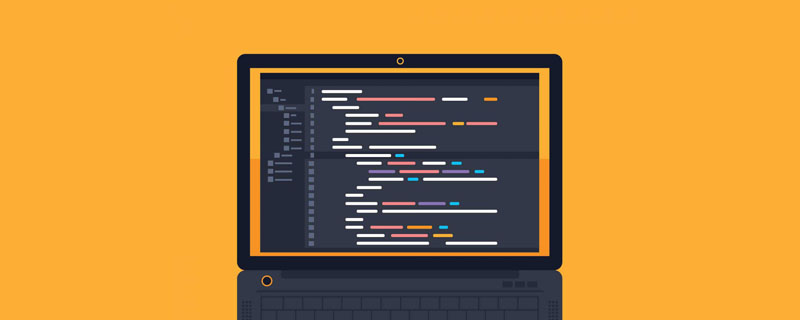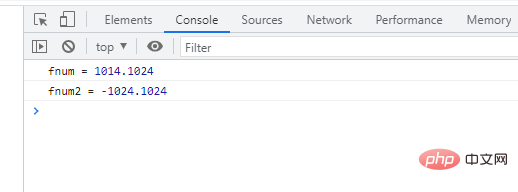What does float mean in javascript
In JavaScript, float means "floating point number" and is represented by Number objects. JavaScript's floating point numbers have two forms of expression: 1. Use ordinary decimal representation, such as "num = 1024.112;"; 2. Use scientific notation, such as "num1 = 1024e3;" or "num2 = 1024e-3;" .

The operating environment of this tutorial: windows7 system, javascript version 1.8.5, Dell G3 computer.
In JavaScript, float refers to "floating point number".
Numbers in JavaScript can be divided into integer and floating-point number types. JavaScript’s floating-point numbers are represented by Number objects. There are two forms of representation of floating point numbers in JavaScript. The first is to use ordinary decimal representation, and the second is to use scientific notation.
Declaring JavaScript floating point numbers
Syntax
var num = 1024.112;
Description
We use the var keyword to declare a floating point variable, num, whose value is 1024.112.
Declaring JavaScript floating point numbers
Syntax
var num1 = 1024e3; var num2 = 1024e-3;
Description
We use the var keyword to declare two floating point variables, namely num1 and num2, whose values are 1024 times 10 to the third power and 1024 times 10 to the -3 power respectively.
JavaScript The scientific notation representation of floating point numbers is to use e as the base, followed by a number, which means multiplying by 10 to the Nth power.
Case
#Define a floating point number
Define a JavaScript floating point number and print
<!DOCTYPE html>
<html>
<head>
<title>JavaScript浮点数</title>
<script type="text/javascript">
var fnum = 1014.1024;
console.log("fnum =", fnum);
var fnum2 = -1024.1024;
console.log("fnum2 =", fnum2);
</script>
</head>
</html>After the program runs, the console output is as follows:

We first use the var keyword to declare a floating point variable fnum and assign it a value of 1024.1024 , and print its content. Then, we define a floating point variable fnum2 again, assign it a value of -1024.1024, and print it.
Scientific notation defines floating point numbers
Uses scientific notation to define floating point numbers
<!DOCTYPE html>
<html>
<head>
<title>使用科学计数法定义浮点数</title>
<script type="text/javascript">
var fnum = 1024e2;
console.log("fnum =", fnum);
var fnum2 = 1024e-2;
console.log("fnum2 =", fnum2);
</script>
</head>
</html>After the program is run, the console output is as follows:

We first use the var keyword to declare a floating point number fnum using scientific notation, and assign it a value of 1024e2, which is 1024 times the square of 10. Then, we A floating point number fnum2 is declared again using scientific notation and assigned a value of 1024e-2, which is 1024 times 10 raised to the power of -2.
【Related recommendations: javascript video tutorial, Basic programming video】
The above is the detailed content of What does float mean in javascript. For more information, please follow other related articles on the PHP Chinese website!

Hot AI Tools

Undresser.AI Undress
AI-powered app for creating realistic nude photos

AI Clothes Remover
Online AI tool for removing clothes from photos.

Undress AI Tool
Undress images for free

Clothoff.io
AI clothes remover

AI Hentai Generator
Generate AI Hentai for free.

Hot Article

Hot Tools

Notepad++7.3.1
Easy-to-use and free code editor

SublimeText3 Chinese version
Chinese version, very easy to use

Zend Studio 13.0.1
Powerful PHP integrated development environment

Dreamweaver CS6
Visual web development tools

SublimeText3 Mac version
God-level code editing software (SublimeText3)

Hot Topics
 1378
1378
 52
52
 How to implement an online speech recognition system using WebSocket and JavaScript
Dec 17, 2023 pm 02:54 PM
How to implement an online speech recognition system using WebSocket and JavaScript
Dec 17, 2023 pm 02:54 PM
How to use WebSocket and JavaScript to implement an online speech recognition system Introduction: With the continuous development of technology, speech recognition technology has become an important part of the field of artificial intelligence. The online speech recognition system based on WebSocket and JavaScript has the characteristics of low latency, real-time and cross-platform, and has become a widely used solution. This article will introduce how to use WebSocket and JavaScript to implement an online speech recognition system.
 WebSocket and JavaScript: key technologies for implementing real-time monitoring systems
Dec 17, 2023 pm 05:30 PM
WebSocket and JavaScript: key technologies for implementing real-time monitoring systems
Dec 17, 2023 pm 05:30 PM
WebSocket and JavaScript: Key technologies for realizing real-time monitoring systems Introduction: With the rapid development of Internet technology, real-time monitoring systems have been widely used in various fields. One of the key technologies to achieve real-time monitoring is the combination of WebSocket and JavaScript. This article will introduce the application of WebSocket and JavaScript in real-time monitoring systems, give code examples, and explain their implementation principles in detail. 1. WebSocket technology
 How to use JavaScript and WebSocket to implement a real-time online ordering system
Dec 17, 2023 pm 12:09 PM
How to use JavaScript and WebSocket to implement a real-time online ordering system
Dec 17, 2023 pm 12:09 PM
Introduction to how to use JavaScript and WebSocket to implement a real-time online ordering system: With the popularity of the Internet and the advancement of technology, more and more restaurants have begun to provide online ordering services. In order to implement a real-time online ordering system, we can use JavaScript and WebSocket technology. WebSocket is a full-duplex communication protocol based on the TCP protocol, which can realize real-time two-way communication between the client and the server. In the real-time online ordering system, when the user selects dishes and places an order
 How to implement an online reservation system using WebSocket and JavaScript
Dec 17, 2023 am 09:39 AM
How to implement an online reservation system using WebSocket and JavaScript
Dec 17, 2023 am 09:39 AM
How to use WebSocket and JavaScript to implement an online reservation system. In today's digital era, more and more businesses and services need to provide online reservation functions. It is crucial to implement an efficient and real-time online reservation system. This article will introduce how to use WebSocket and JavaScript to implement an online reservation system, and provide specific code examples. 1. What is WebSocket? WebSocket is a full-duplex method on a single TCP connection.
 JavaScript and WebSocket: Building an efficient real-time weather forecasting system
Dec 17, 2023 pm 05:13 PM
JavaScript and WebSocket: Building an efficient real-time weather forecasting system
Dec 17, 2023 pm 05:13 PM
JavaScript and WebSocket: Building an efficient real-time weather forecast system Introduction: Today, the accuracy of weather forecasts is of great significance to daily life and decision-making. As technology develops, we can provide more accurate and reliable weather forecasts by obtaining weather data in real time. In this article, we will learn how to use JavaScript and WebSocket technology to build an efficient real-time weather forecast system. This article will demonstrate the implementation process through specific code examples. We
 Simple JavaScript Tutorial: How to Get HTTP Status Code
Jan 05, 2024 pm 06:08 PM
Simple JavaScript Tutorial: How to Get HTTP Status Code
Jan 05, 2024 pm 06:08 PM
JavaScript tutorial: How to get HTTP status code, specific code examples are required. Preface: In web development, data interaction with the server is often involved. When communicating with the server, we often need to obtain the returned HTTP status code to determine whether the operation is successful, and perform corresponding processing based on different status codes. This article will teach you how to use JavaScript to obtain HTTP status codes and provide some practical code examples. Using XMLHttpRequest
 How to use insertBefore in javascript
Nov 24, 2023 am 11:56 AM
How to use insertBefore in javascript
Nov 24, 2023 am 11:56 AM
Usage: In JavaScript, the insertBefore() method is used to insert a new node in the DOM tree. This method requires two parameters: the new node to be inserted and the reference node (that is, the node where the new node will be inserted).
 JavaScript and WebSocket: Building an efficient real-time image processing system
Dec 17, 2023 am 08:41 AM
JavaScript and WebSocket: Building an efficient real-time image processing system
Dec 17, 2023 am 08:41 AM
JavaScript is a programming language widely used in web development, while WebSocket is a network protocol used for real-time communication. Combining the powerful functions of the two, we can create an efficient real-time image processing system. This article will introduce how to implement this system using JavaScript and WebSocket, and provide specific code examples. First, we need to clarify the requirements and goals of the real-time image processing system. Suppose we have a camera device that can collect real-time image data




